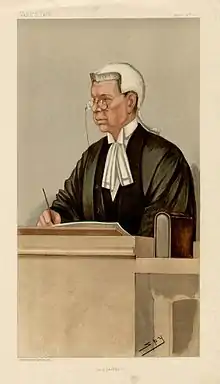John Lawrance
Sir John Compton Lawrance DL (30 May 1832 – 5 December 1912)[1] was an English judge and Conservative Party politician.

Biography
Lawrance was the son of Thomas Munton Lawrance of Dunsby Hall, Lincolnshire and his wife Louisa Compton. He was called to the bar at Lincoln's Inn in 1859, and became a QC in 1877. He became Recorder of Derby in 1879 and was a J. P. for Lincolnshire.[2]
In 1878, Lawrance stood unsuccessfully for Parliament at a by-election in Peterborough,[3] but at the 1880 general election he was elected as Member of Parliament (MP) for South Lincolnshire.[4] That constituency was abolished under Redistribution of Seats Act 1885, and at the 1885 general election Lawrance was elected MP for Stamford.[5] He was appointed as a Deputy Lieutenant of Lincolnshire in September 1886.[6]
Lawrence became a High Court Judge in 1890[7] and was also appointed as one of the Judges for the trial of election petitions.[8] Giving the Plymouth Law Society's Annual Pilgrim Fathers Lecture in December 2009, Lord Justice Toulson recounted that Lawrance's appointment to the High Court had been greeted with ‘hoots of derision’[9][10] and that the Law Times had written "This is a bad appointment, for although a popular man and a thorough English gentleman, Mr. Lawrance has no reputation as a lawyer, and has been rarely seen of recent years in the Royal Courts of Justice".[9][11] Lawrance's tardiness in giving judgements led to his nickname of ‘Long’ Lawrance, Toulson observing that: "the shameful way in which commercial disputes were being dealt with – or not dealt with – by hopelessly bad judges, especially Lawrance, was causing serious damage to the City of London and its commercial reputation".[9] As a consequence, the Commercial Court was created; Toulson recalled that in 1944 Lord Justice MacKinnon had said: "When I was the pupil of T. E. Scrutton from 1896 to 1897, he told me that the Only Begetter of the Commercial Court was ‘Long’ Lawrance. Mr Justice J. C. Lawrance was a stupid man, a very ill-equipped lawyer, and a bad judge....".[9][12]
Lawrance lived at Dunsby Hall, near Bourne, Lincolnshire and died at the age of 80
Lawrance married Charlotte Georgina Smart in 1861.
References
- Leigh Rayment's Peerage Pages – Peerages beginning with "S" (part 4)
- Debretts Guide to the House of Commons 1886
- Craig, F. W. S. (1989) [1977]. British parliamentary election results 1832–1885 (2nd ed.). Chichester: Parliamentary Research Services. p. 238. ISBN 0-900178-26-4.
- Craig, op. cit, page 423
- Craig, F. W. S. (1989) [1974]. British parliamentary election results 1885–1918 (2nd ed.). Chichester: Parliamentary Research Services. p. 343. ISBN 0-900178-27-2.
- "From the LONDON GAZETTE, Tuesday, Sept. 7. St. James's Palace, Sept. 7". The Times. London. 8 September 1886. p. 11, col A.
- The records of the honorable society of Lincoln's Inn. The Black books (1897)
- Hansard Millbank Systems The Worcester Election
- Toulson, Roger (3 December 2009). "Judging judicial appointments" (PDF). Archived from the original (PDF) on 2 April 2015. Retrieved 10 March 2015.
- Stevens, Robert (18 October 2002). The English Judges: Their Role in the Changing Constitution. Hart Publishing. p. 95. ISBN 978-1841132266.
- Heuston, R. F. V. (1964). Lives of the Lord Chancellors (1885 – 1940). Clarendon Press. p. 45. ASIN B0000CM3YN.
- MacKinnon, "The Origin of the Commercial Court," (1944) LQR (60), 324–325.
- "Lincoln's Inn Great Hall, Wc4 Lawrance, J". Baz Manning. Retrieved 19 December 2020.
External links
- Hansard 1803–2005: contributions in Parliament by John Compton Lawrance
| Parliament of the United Kingdom | ||
|---|---|---|
| Preceded by Sir William Welby-Gregory Edmund Turnor |
Member of Parliament for South Lincolnshire 1880–1885 With: Sir William Welby-Gregory 1880–1884 Murray Finch-Hatton |
Constituency abolished |
| Preceded by Marston Clarke Buszard |
Member of Parliament for Stamford 1885–1890 |
Succeeded by Henry Cust |